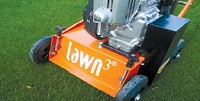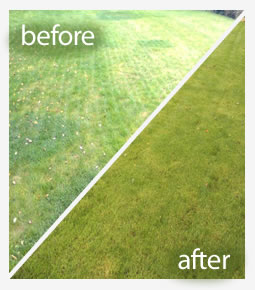Scarifying
 Scarifying is the principle method of removing dense moss and lawn debris – thatch. It is an important component of good lawn care. A commercial Scarifier has metal blades, rather like circular pastry cutters, mounted in a row about eighteen inches wide under a cutting deck. The machine looks rather like a lawn mower and it is driven across the lawn in a similar fashion.
Scarifying is the principle method of removing dense moss and lawn debris – thatch. It is an important component of good lawn care. A commercial Scarifier has metal blades, rather like circular pastry cutters, mounted in a row about eighteen inches wide under a cutting deck. The machine looks rather like a lawn mower and it is driven across the lawn in a similar fashion.
Number of Treatments – Typically once every one or two years
Timing of Treatments – Best undertaken in spring or autumn when the grass is growing vigorously, to assist in recovery.
Treatment Type – An additional Lawn 3 treatment
- The cutting disks are lowered onto the soil surface and cleanly cut-out the debris from the lawn rather than ripping it out or tearing it, as experienced when a domestic product is used that utilises small metal hooks. Hooks which also shred the sward – potentially creating the opportunity for lawn disease and die back.
- When moss is dense the lawn is scarified in several directions creating a chequer board effect. This enables the removed cut-out moss to be raked up and disposed of and the lawn over-seeded. It is a procedure undertaken as part of a moss control program and in conjunction with moss killing chemicals.
- Scarifying to remove moss and thatch is best undertaken when the lawn is growing vigorously – spring and autumn. This ensures the lawn quickly recovers from the procedure and it is not left looking poorly for several months as can be the case when the lawn is dormant.
- A single pass scarification is beneficial to a lawn because it can cut the lateral roots of the grass forcing the centre root to grow deep. It also prevents thatch build up and can be undertaken every one to two years as part of the lawn care program.
- Deep thatch can be a killer for a lawn and scarifying is the only effective way to remove it. Deep thatch in an old lawn harbours disease, pests and weed seeds and prevents moisture and feed getting to the root ball. In dry summer conditions a lawn will often die as opposed to becoming dormant from which an autumn recovery occurs.
- Fine blade lawns often become very dense when they age and become unsightly. A single pass scarification thins the sward and rejuvenates the aged lawn, especially if it is aerated and fed at the same time.




